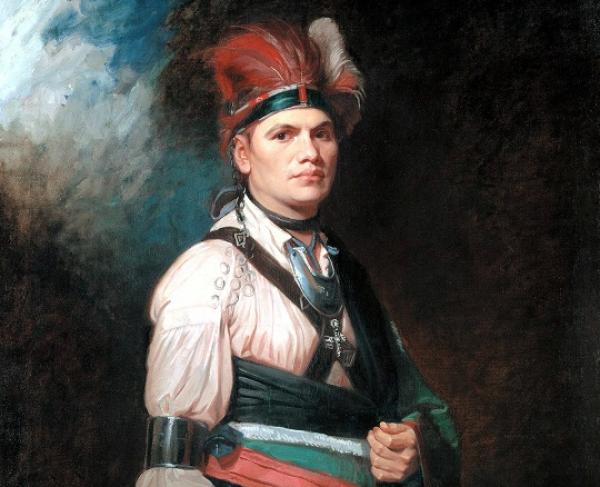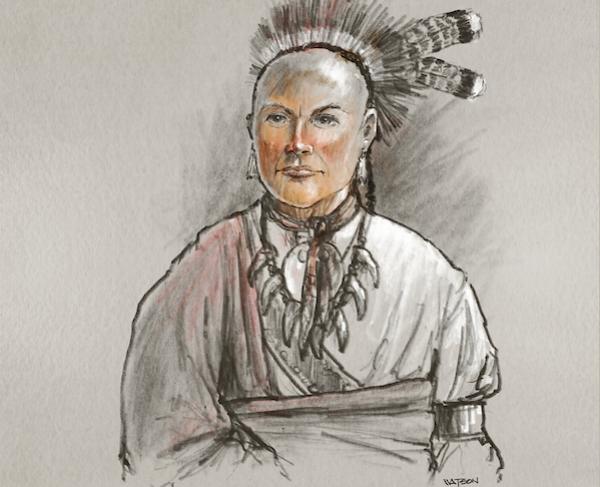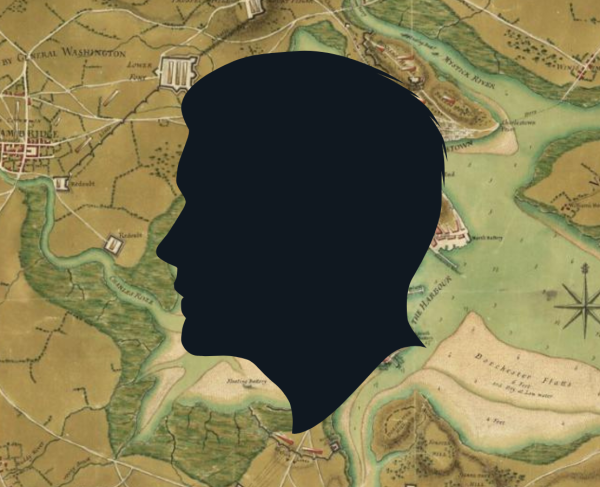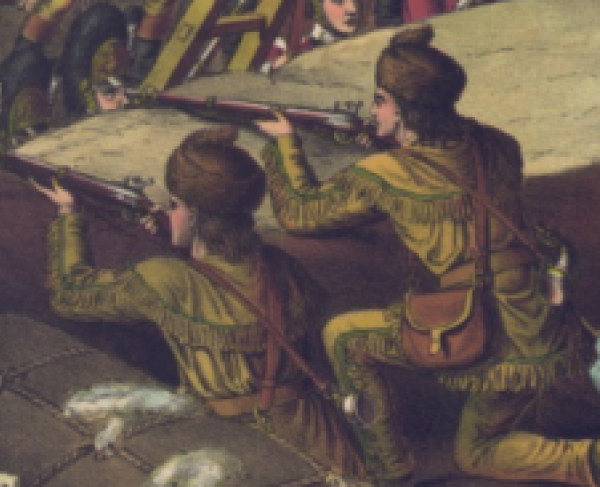Joseph Brant

One of the most controversial figures of the American Revolution, Joseph Brant (Mohawk name Thayendanegea), was born along the Cuyahoga River in 1742. His parents were part of the Mohawk Tribe from New York but had traveled to the Ohio territory to hunt. His family returned to the Mohawk and Iroquois lands where Brant grew up; and where he became a polyglot, a war chief, and a diplomat.
In his early life, the young Mohawk became a favorite of the British. He was especially championed by the superintendent of the Northern Indians of America, Sir William Johnson. In 1759, Johnson married Brant’s sister Molly. The marriage was incredibly advantageous to the aspiring leader. Through Johnson, Brant gained connections to the British government and education. Johnson selected Brant and several other Mohawks to attend Moor’s Charity School for Indians, a school which would later develop into Dartmouth College. At school, Brant converted to the Anglican faith and learned to read and write English. While Brant’s education at Moor’s gave him the skills which made him prosperous, most students at Moor’s were not nearly as successful as Brant. The school’s administrators and employees abused their power to force students not deemed “the best” into massive amounts of manual labor.
After receiving his education, he returned to Johnson’s side during the French and Indian War. After the war concluded, Brant stayed with his brother in law and assisted in running the British “Indian Department.” During this time, he traveled throughout the Iroquois land, mainly as a missionary. Throughout his travels, Brant learned to speak at least three languages of the different Iroquois tribes and likely spoke all six tribal languages. These early missionary years established Brant as a trusted and respected leader of both natives and settlers.
In 1775, after the battles at Lexington and Concord, the Six Nations met to discuss their role in the burgeoning War for independence. While many advocated for neutrality, almost prophetically, Brant predicted that independence for the colonists meant that the natives across the North American continent would lose their land. Brant’s argument, along with Johnson’s influence, succeeded in convincing four of the six nations to fight for the British cause, the Mohawks, Onondagas, Cayugas, and the Senecas.
Later in November 1775, Brant traveled to England to discuss native roles in the War along with land disputes. During the trip, the British aristocracy came to adore Brant. He made many influential friends, and they showered him with gifts. The British ruling class, so impressed by Brant, promised him that the native loyalists would be used in the war. Brant returned to America in July of 1776 and participated in the British campaign to retake New York. The record of Brant’s service is unknown, it is likely he served with General Hugh Percy during the British push through Jamaica Pass, which was a key phase of the Battle of Long Island. The young Mohawk and Percy quickly formed a lifelong friendship. Percy would be the only white man which Brant would remain close with after the war. After the New York campaign, Brant returned to the Six Nations, where he rallied the tribes for war against the American colonists.
Throughout 1777 and 1778, Brant’s forces became exclusively involved in the Mohawk Valley. Brant’s army participated at the Battle of Oriskany, in attacks on Cobleskill, and in raids on German Flatts. While Brant’s forces were on a raid, continental troops attacked Brant’s Onoquaga base. The continentals razed the city, leaving buildings burned, cattle dead, and crops reaped. Brant, as a response, led the attack which became known as the Cherry Valley Massacre. During the attack, Seneca forces sought out innocents killing at least thirty civilians. This action gave Brant a reputation for brutality and the nickname “Monster Brant;” however, this reputation was entirely undeserved. Brant, although active in the valley, was not present at the Cherry Valley Massacre, further primary sources from British leaders and Brant show he attempted to contain the Seneca’s’ violence.
By 1779, the British had come to respect Brant’s command. They granted him the rank of “Captain of the Northern Confederated Indians” and promised provisions for his men but no pay for the native troops. Because of his new salary and wartimes despoiling, Brant became moderately wealthy. This wealth caused jealousy among rival chiefs and even his unpaid volunteers. As a commission to make Brant a colonel came, British colonial officers did not tell Brant in order to preserve his negotiating power with other tribes. In late 1779, the Sullivan Campaign forced Brant and the native resistance out of New York, pushing them back to Fort Niagara.
In 1781, the British sent Brant west to the Ohio Country. During this campaign, Brant was seriously injured in the leg and was forced to recover at Fort Detroit. During this time, the diplomat and warrior, continually tried to keep western tribes loyal to the British, even after the crown’s catastrophic defeat at Yorktown. Late in 1782 Brant’s troops continued their guerilla attacks but achieved few substantial victories.
When the war for independence concluded in 1783, the Treaty of Paris did not acknowledge the Six Tribes or any indigenous groups independence. The British had failed to accomplish the promise which prompted many native tribes to join their cause, the protection of indigenous land. Brant would spend the rest of his life fighting for the land rights of his people and other disaffected indigenous tribes in America. His first attempt at protecting the land was forming the Western Confederacy, a group of thirty native nations which agreed to fight for the Fort Stanwix Treaty line. Brant sought British support in 1785, and while the British compensated Mohawk losses in the war and gave Brant a pension, they refused to join in support of the thirty tribes. Brant and Washington both made attempts at peace. Brant sought a peace treaty but failed. Washington tried to create a reservation for the Mohawks and give Brant a large pension, but Brant refused. The American forces overwhelmed the Western Confederacy resulting in the thirty tribes’ alliance disintegrating.
The rest of his life was spent tangling with American, French, Canadian, and British bureaucracies in an attempt to establish a place for his people to live. Brant never successfully negotiated a future for his people, although it was through no fault of his own, but rather the differing goals of all the powers involved in the negotiations. Brant died at his home in Ontario on November 24, 1807. Since his death, Brant’s legacy has been contested by nearly everyone who interacted with him. As the most prominent negotiator and diplomat of Northern indigenous peoples during the Revolution, every power active in his negotiations regarded him differently. Brant’s legacy, however complicated, can be succinctly summed up in his own last words, “Have pity on the poor Indians. If you have any influence with the great, endeavor to use it for their good.”


